We had several surprises during our regular Thursday morning volunteer time at Harlingen’s Hugh Ramsey Nature Park.
The first surprise was a special guest: Valley Morning Star Ace Reporter and Photographer Rick Kelley, an advocate of native habitat, birds, Ramsey Park and our volunteer team.
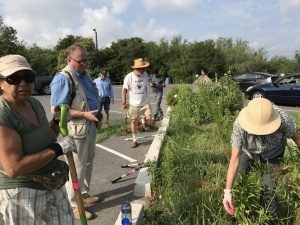
If you missed his story in the Valley Morning Star, check it out here: http://www.valleymorningstar.com/news/local_news/article_78b2db10-635b-11e7-ab21-1bb4f3f3fd74.html
The scheduled project that day was maintenance at the park’s parking lot bioretention basin.
While we weren’t looking, the plantings in the basin grew up and out.
Compare the above June 29, 2017, shot with Rick Kelley’s June 25, 2016, VMS-published photo below, just one year previously, when Texas Master Naturalists planted some 100 plants and trees selected by Harlingen Native Plant Nurseryman Mike Heep.
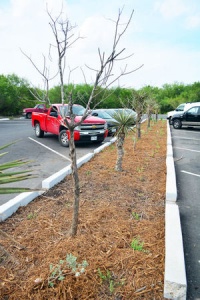
The basin had some growing pains, or perhaps, un-growing pains, when some of the heat-of-the-summer-planted trees didn’t survive. Mike Heep had planned for that possibility, and in July other trees replaced the dead ones.
Different species were included in the re-plant as the basin had time to let us know how it was going to act. For instance, one end appeared to remain damper than expected so Frank Wiseman suggested a rare button bush that doesn’t mind its feet being wet.
The Mexican buttonbush or willow leaf buttonbush, Cephalanthus salicifolius, is pretty exciting for our volunteer group. Not only is it rare, the two shrubs were planted at our suggestion, and the flowers are fabulously interesting! Buttonbush usually grows in wet soils near the Rio Grande, but even there, we’d be hard-pressed to find one.
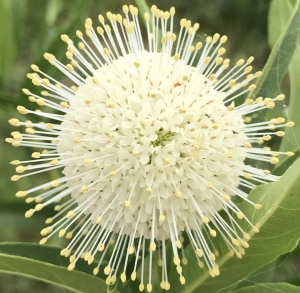
It’s an excellent nectar source for butterflies. Check out the Dr. Richardson/Ken King book, Plants of Deep South Texas, page 369.We’re hoping our Mexican buttonbushes will have long and prosperous lives for both human and butterfly visitors to the park.
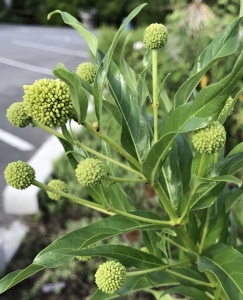
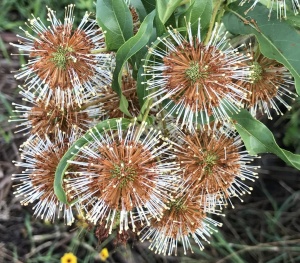
The Cenizo (Texas Purple Sage, Leucophyllum frutescens) bushes came alive with the recent half-inch rainfall over the park, glowing nearly iridescent in the early morning light.
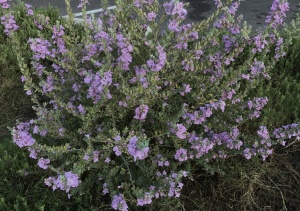
In addition to checking the progress of established plants, we discovered a lot of wonderful surprise plants worth keeping.
Climbing hemp weed, Mikania scandens, PDST, page 113, was found shooting out of the snake herb, which was a fun surprise.
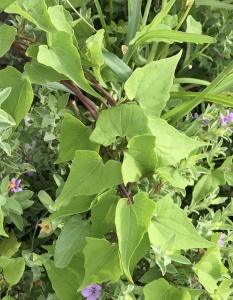
An important nectar plant, climbing hemp weed blooms summer and fall and also is host to little metalmark butterfly, Calephelis virginiensis. The blooms are clusters of white flowers that look very similar to the more familiar blue-blooming butterfly magnet mist flower.
Crenate leaf snake herb, Dyschoriste crenulata, page 49, PDST, — also a great butterfly nectar source — is doing exactly as promised. It has spread from about 50 little sprigs planted around the inside of the curbing and, in just one year, has become a great drought-tolerant, blooming, ground cover.
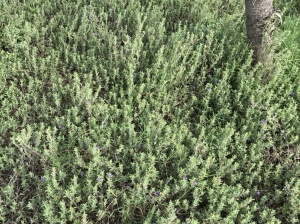
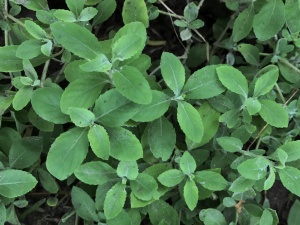
Other seeds that may have hitched a ride in the purchased plants are climbing milkweed, Funastrum cynanchoides, PDST, page 79, (monarch butterfly host plant), Indian heliotrope, coreopsis, purple marsh fleabane, frog fruit, American germander, and silver bluestem and rustyseed Paspalum grasses.
Another exciting find, growing at a slice in the curb, is a plant about 12 inches tall, with tiny, delicate leaves and even tinier buds and flowers. Another one is about five feet away. They are a species of croton. We’re still searching to determine the specific species.
Christina Mild is fairly sure that this is the first time we’ve encountered this species in Ramsey. We’ll watch to see if they are annual or perennial.
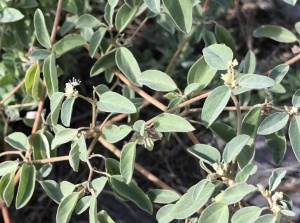
Pyramid flower, Melochia pyramidata, page 405, PDST, rose out of the ground cover, too, with its bright green, serrated leaves and tiny lavender flowers. It grows in hot, dry places and is a good butterfly nectar plant.
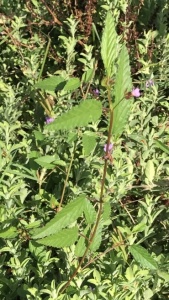
A volunteer amaranth, possibly Palmer’s pigweed, Amaranthus palmeri, page 61, PDST, is a keeper. This plant, with lovely dark red seed heads, provides excellent food for birds.
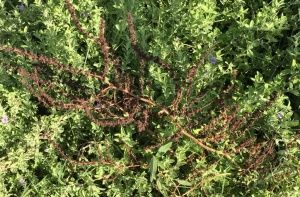
Another pop-up surprise is what we believe to be a species of Iva, possibly Iva annua var. caudata, because the leaves were wide rather than narrow. PDST, page 110. Its common name is sumpweed. Many plants are recognized by the scent of their crushed leaves. Interestingly, this plant smells like bleach. When I sniffed a crushed leaf, I was transported back to my laundromat days.
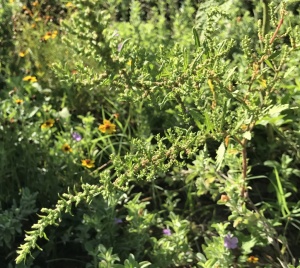
All is not as it should be, however. Fast-growing and invasive Roosevelt weed (Depression weed) Baccharis neglecta, PDST, page 88, shot up while we concentrated on Ebony Loop gardens this past spring, but Volker to the rescue. He made short work of digging up roots and all of the pesky trees with help from Jorge and Rolando.
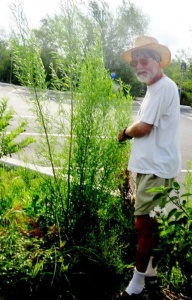
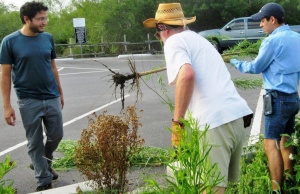
Christina Mild waged war on errant, giant horse weed, Conyza canadensis var. glabrata, PDST, page 93, fortunately easy to pull up by the roots after the recent rainfall, proving that in a healthy habitat, it can exceed its average height of three to four feet! Although native, Christina noted that it doesn’t seem to provide much benefit to wildlife. Being tall and weedy-looking, it detracted from the aesthetics of the basin. Out it went! There’s plenty of it down by the Arroyo bank.
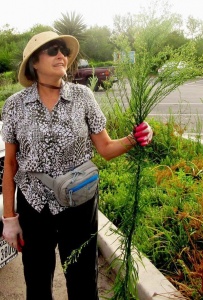
The bioretention basin is the second such parking lot treatment in the Valley; the first is in a shopping center parking lot in Edinburg. These basins are constructed to help filter out oil and other pollutant runoff before stormwater reaches its final destination.
Bioretention basins are landscaped depressions or shallow basins. Stormwater is directed to the basin and then percolates through a system of plants, roots, sand, rock and other substances, where it is treated by physical and biological processes. The slowed, cleaned water is allowed to infiltrate native soils or directed to nearby stormwater drains or receiving waters.
It’s a pretty cool system. Functional and attractive.
Google bioretention basin or bioretention systems for complete technical information.

Leave a Reply